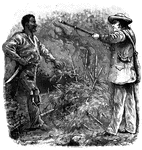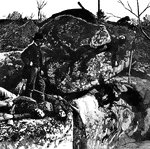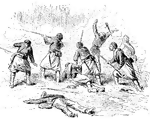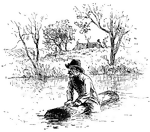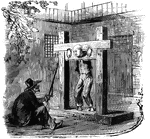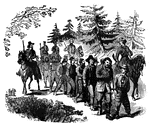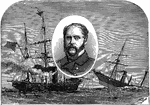The Miscellaneous Civil War ClipArt gallery includes 181 illustrations of general topic from the American Civil War, fought between the North (Union) and the South (Confederacy).

Thirteen-inch Shell Mortar Practice
"Mortar practice- 13-inch shell mortar, as used by the Federal government- weight of mortar 17,000 pounds."…

Mortar Practice - Rear View
"Mortar practice- rear view of 13-inch mortar, with its usual complement of seven gunners. The mortar…
New Jersey Troops
"The New Jersey troops crossing the Chesapeake Bay, in sixteen propellers, on their way to Washington,…

New York Seventh Regiment Marching Down Broadway
The secessionists tore up the railroad but the men of the eighth Massachusetts knew how to build railroads.…

Night Burial of Colonel Garesche
"Night burial of Colonel Garesche, Chief of Staff to Major General Rosecrans, on the battlefield of…
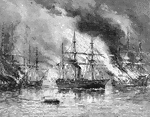
Norfolk Navy Yard Burning
The Norfolk Naval Yard, also known as the Norfolk Naval Shipyard became an integral shipyard during…

Officer's Tents
"New Jersey Camp at Arling, Va., designated as Camp Princeton in honor of one of the Revolutionary battle…

Palmetto Cockade
Ornaments made of blue silk ribbon with a button in the center bearing the image of a palmetto tree.…
President Lincoln's Pen
The pen with which President Abraham Lincoln wrote the Emancipation Proclamation.

Battle of Fort Pillow
Battle of Fort Pillow is also known as the Fort Pillow Massacre, fought on April 12, 1864 on the Mississippi…

Pittsburg Landing in Tennessee
Pittsburg Landing is a town in Hardin County, Tennessee and is named for the industrial heritage of…
!["The Plantation Police, or Patrol, was an institution peculiar to the Slave States. It was a semi-military organization, raised and supported by the planters, but recognized by the old State authorities. Their principal duty was to visit the various plantations and patrol the roads at night, arresting all [African Americans] and others not having proper passes. The war, the President's proclomation, and the actual possession of most of the State of Louisiana by the Federal authorities, rendered these patrols doubly rigorous. Some of the [African Americans] submitted reluctantly. The [African American] in the foreground is a speciman of this class. He seems to yield to the superior force of a tottering power, satisfied that his day is at hand; others show the obsequious, submissive stamp- the [African American] satisfied with his lot if he is clothed and fed."— Frank Leslie, 1896](https://etc.usf.edu/clipart/11600/11643/plant-police_11643_mth.gif)
Plantation Police
"The Plantation Police, or Patrol, was an institution peculiar to the Slave States. It was a semi-military…

Port Hudson
"The advance of Port Hudson. The baggage train of General Augur's division crossing the Bayou Montecino,…
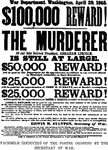
Reward Poster
The reward poster ordered by te Secretary of War after President Lincoln's assassination.

Rhode Island Regiments
"Rhode Island Regiments embarking at Providence for New York and Washington. Within five days after…

Rifle Pits
"Siege of Vicksburg- sharpshooters in the rifle pits constructed by Captain Hickenlooper."— Frank…

Sawyer gun
"Practicing with the celebrated Sawyer gun on the Confederate batteries at Swell's Point, near Norfolk,…
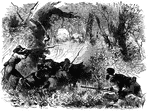
Scouting Party
Scouting party of the ninth Indian volunteers, or, as they were called, "The tigers of the bloody ninth."
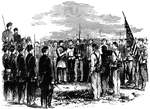
Seventy-ninth Regiment
"Taking away the colors of the Seventy-ninth New York Regiment for insubordination and mutiny, Washington,…

Sherman and His Generals
William Tecumseh Sherman served as a General in the Union Army during the American Civil War (1861–65).…

Signal Station
"Federal signal station on Loudoun Heights, Harper's Ferry, communicating with the station on Maryland…
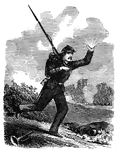
signal with glass
"Signaling with a piece of looking glass. Hints to Soldiers in the camp and on campaign."— Frank…

The Sixth regiment
Thousands of patriotic citizens filled every available space in the big railroad station in Jersey City…
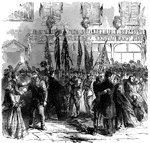
Soldiers Resting
"The soldier's rest--the friends of the Seventh and Eighth Regiments, New York Volunteers, welcoming…
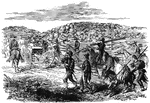
Southern Caricature
"A southern caricature- 'Generals Wheeler and Wharton falling slowly back, contesting every foot of…

Stafford's Store
"Going into camp at Stafford's store, Va. Third Brigade, Third Division, Sixth Corps, carrying off rails…

State Prisoners at Fort Lafayette
"Landing state prisoners at Fort Lafayette, New York harbor, in 1861. Fort Lafayette, New York harbor,…

Stockades at Newport News
"Erecting stockades at Newport News, Va., by the Federal Troops, June 1861."— Frank Leslie, 1896

Battle of Stones River Scene
Scene in the afternoon at the Battle of Stones River, also known as the Second Battle of Murfreesboro…

Battle of Stones River
The Battle of Stones River, also known as the Second Battle of Murfreesboro was fought from December…

Thanksgiving Ball
"Soldiers and women participating in a Thanksgiving Ball. Thanksgiving festivities at Fort Pulaski,…
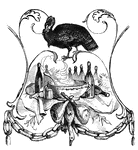
Thanksgiving Dinner
"Thanksgiving dinner. Thanksgiving festivities at Fort Pulaski, Ga., Thursday, November 27th, 1862.…
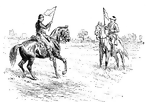
Flag of Truce
Civil War soldiers waving the flag of truce, signaling a halt in fighting for both sides.

A Union Device
"Unite or Die." This snake device first appeared when the Stamp Act excitement was at its height.

Union Uniforms
This sketch depicts Americans exchanging rags for U.S. Army clothing or uniforms to fight for the Union…

Vermont Regiment
"Encampment of the First Vermont Regiment, Colonel Phelps, at Newport News, Va."— Frank Leslie, 1896
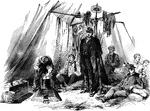
Thirteenth Illinois Volunteers
"Scene in camp life- company mess of the Thirteenth Illinois Volunteers in their camp before Corinth,…

Wheelbarrow Race
"Soldiers aparticipating in a wheelbarrow race. Thanksgiving festivities at Fort Pulaski, Ga., Thursday,…

Dog at Winchester
"Sheridan's Campaign- an incident at the Battle of Winchester- a faithful dog watching and defending…

Wounded Federals
"Towing the wounded Federal soldiers down the bayou on a raft, on the night of January 14th, 1863, after…

Zouave Cadets
"Group of Ellsworth's Chicago Zouave Cadets. No military organization during the war was more brilliant…

